Seagull
Larus argentatus
Some gulls are capable of using tools
Advertisement
Seagull Scientific Classification
- Kingdom
- Animalia
- Phylum
- Chordata
- Class
- Aves
- Order
- Charadriiformes
- Family
- Laridae
- Genus
- Larus
- Scientific Name
- Larus argentatus
Read our Complete Guide to Classification of Animals.
Seagull Conservation Status
Seagull Facts
- Prey
- Fish, insects, earthworms, rodents, reptiles, amphibians, birds, and more
- Fun Fact
- Some gulls are capable of using tools
- Estimated Population Size
- millions
- Biggest Threat
- Overfishing and climate change
- Most Distinctive Feature
- The long bill, hooked at the end
- Other Name(s)
- mews
- Wingspan
- up to 67 inches
- Incubation Period
- one month
- Habitat
- Coasts and beaches
- Predators
- Raccoons, cats, foxes, minks, and birds of prey
- Diet
- Carnivore
- Type
- bird
- Common Name
- seagull
- Number Of Species
- -2
- Average Clutch Size
- 2
- Nesting Location
- Ground and cliff sites
- Age of Molting
- one to two months
- Migratory
- 1
View all of the Seagull images!

“Seagulls are symbols of versatility and freedom in traditional Native American cultures.”
Among the most tenacious and clever foragers on the planet, the seagull belongs to a family of birds that lives near the coast. There are more than 50 documented species found all over the world. The most common species you’re probably familiar with are the European herring gull and the American herring gull, but there’s plenty of diversity across the entire family. This article will cover some interesting facts about the appearance, behavior, and diet of the seagull.
Seagull vs. Eagle
Seagulls do share some superficial resemblance with an eagle, including a large body and hooked bill, but gulls are generally not considered to be birds of prey. They are more closely related to auks, plovers, and other shorebirds, whereas eagles are related to kites and vultures.
3 Incredible Seagull Facts!
- The seagull is considered to be among the most intelligent birds in the world. Some gulls will drop a mollusk shell onto a rock to break it open. Others have been observed baiting fish with bread. One of the most amazing facts is that they can remember new foraging strategies and pass them down to the next generation of gulls.
- Unlike most animals, the seagull can drink both freshwater and saltwater. A specialized gland right above the eyes can collect and then flush out the salt right through the nostrils.
- Seagulls have a small claw halfway up the lower leg that allows them to roost on high ledges without falling off.
Where to Find the Seagull
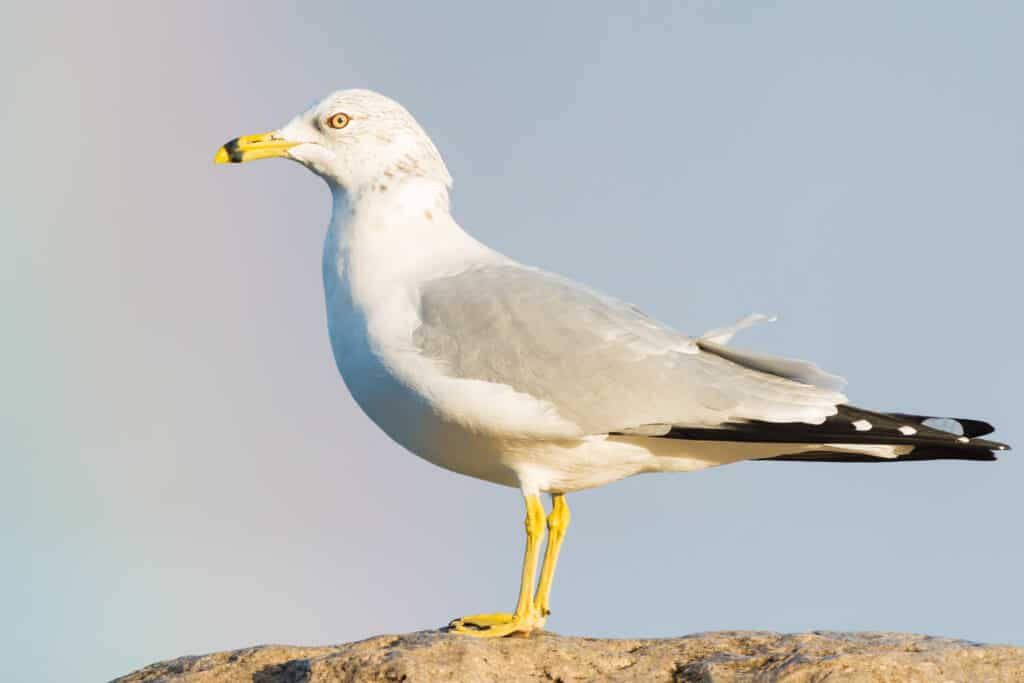
Gulls are large intelligent birds which can be found on every continent including Antarctica and the Arctic
©iStock.com/PaulReevesPhotography
The majority of seagulls can be found near coastal habitats all over the world, particularly in the Northern Hemisphere. Some gulls will travel far inland in the non-breeding season, but otherwise, they stick close to the ocean habitats.
Seagulls are found on every continent in the world, including the Antarctica and the Arctic. They generally prefer coastal plains and often form large colonies on small islands near the coastline. They are less fond of tropical regions, but can be found there as well. The biggest influence on their distribution is the availability of food. Seagulls are opportunistic and will follow their food source. As a result, human fishing endeavors play a big part in their distribution and population density.
Nests
Most seagulls build their nest in a hollow depression on the ground (and sometimes cliffs) out of vegetation, feathers, rope, and even plastic. The nest is usually located next to a rock, log, or bush to protect it from predators.
Evolution and Origins
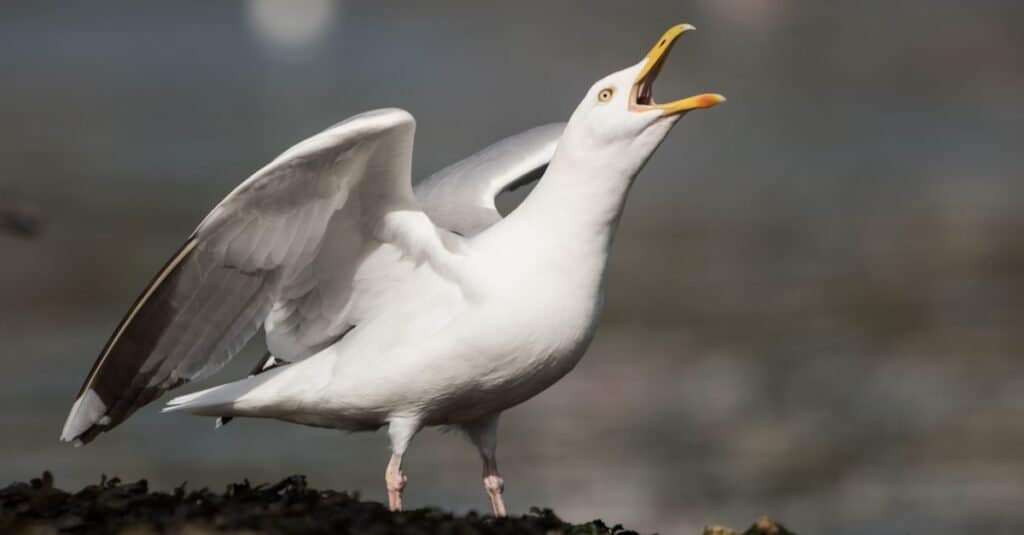
Gulls are distant relatives of auks and skuas
©Maciej Olszewski/Shutterstock.com
Gulls belong to a large family of seabirds known as Laridae. This vast collective consists of 22 genera and 100 species and also includes kittiwakes, terns, and skimmers. Before the Cretaceous Period (i.e., between 66 – 145 million years ago), the Laridae was part of the family that would give rise to auks and skuas. As a result, gulls are their distant relatives, even though the Laridae went on to separate from that branch during the Cretaceous. Diversification followed during the Paleocene, about 60 million years ago. Evidence of the Laridae has also been found during the earlier stages of the Oligocene Era, between 30 – 33 million years ago. What’s more, species related to gulls dating back to the Miocene about 23 – 5.3 million years ago, were also reported to have been discovered in France.
Types
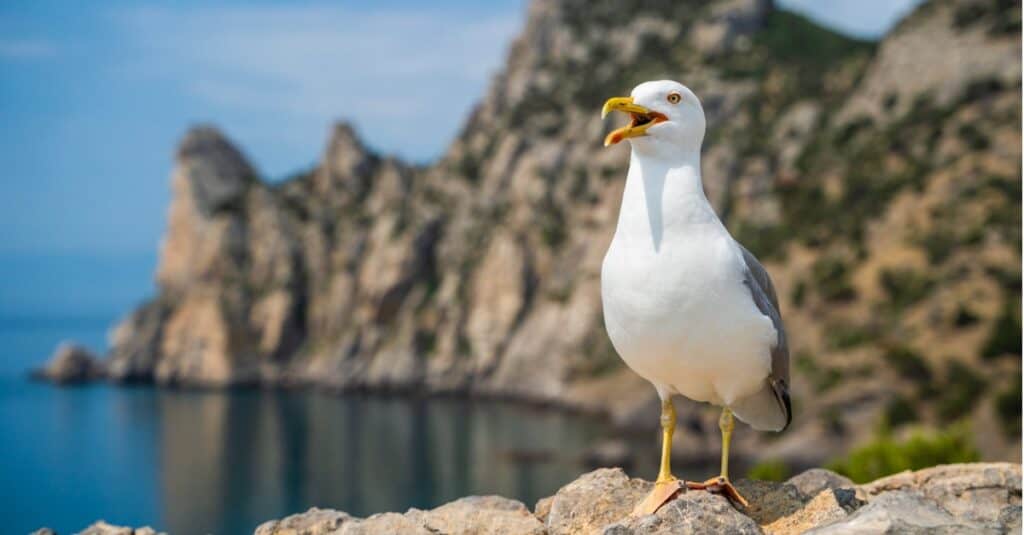
Several gull species have snow-white head and chest feathers, and silver wing feathers.
©iStock.com/Evgenyi_Eg
There are 51 species of gulls, some of the common are:
- California Gull (Larus californicus): These gulls can be found in lakes and marshes from Canada to Colorado. They spend their days searching for food on the water, or heading for parks and beaches where they approach beachgoers to ask for food.
- Dolphin Gull (Leucophaeus scoresbii): Recognizable by its mottled head feathers and reddish beak, this species can be found in Argentina and Chile. It tends to form colonies of a few hundred birds and nests on cliffs, or sandy beaches.
- Herring Gull (Larus argentatus): Found all over Europe with the exception of the south, this species can be found in large numbers in Britain, Iceland, and Ireland. It is somewhat omnivorous with a diet generally consisting of crustaceans, fish, plants, and food pilfered from unsuspecting humans.
- Pacific Gull (Larus pacificus): Native to Australia, this large gull is recognizable by its white head, orange-reddish beak, and dark wing and back feathers. It enjoys a mainly crustacean-based diet and is also adept at pilfering food from other birds.
- Ivory Gull (Pagophila eburnea): At a first glance, this small-sized member of the species might be mistaken for a pigeon. It is recognizable by its plumage which is snow white, and its blue yellow-tipped beak. The ivory gull breeds in North America, Greenland, and Eurasia.
- Black-headed Gull (Chroicocephalus ridibundus): Its key distinguishing feature are its black head feathers which turn white in winter. This species is known to carefully remove any eggshells from its nest once its young have hatched. It can be found all over Europe and also in parts of Canada, China, and Japan.
- Black-billed Gull (Chroicocephalus bulleri): Noticeable for its black bill, predominantly snow-white head and chest, and wings covered in pale silver feathers, this gull is also known for its legs which morph from black to red during the mating season. It is located in New Zealand which is its only home where it is known as tarāpuka in Maori.
- Ring-billed Gull (Larus delawarensis): This gull which breeds in North America and Canada can be instantly recognized by its short yellow beak with a thick black band closer to the tip. Its feathers are silver on its wings, white on its head, neck, and chest, and black on its tail.
(Additional species comprising the total list can be seen in the last section of the article.)
Size, Appearance, and Behavior
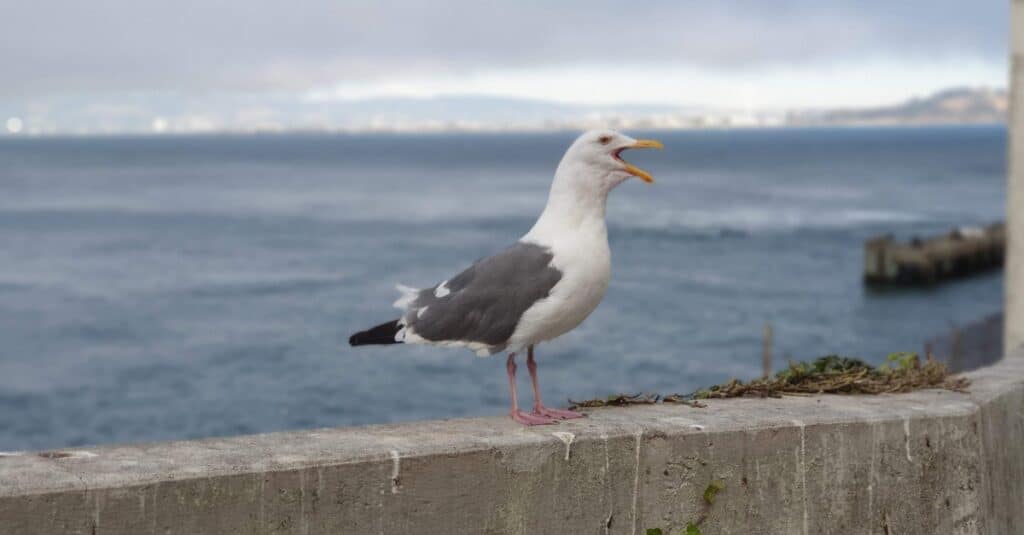
Gulls are social birds which live in large colonies around the coast
©iStock.com/autina
Seagulls are fairly easy to identify from their big, bulky bodies, sinewy legs, long wings, and stout bills, which end in a hook. Their bodies are normally covered in white, gray, and sometimes even black plumage, but the color of the head can vary by species. While the American and European herring gulls sport white heads, several species, including the Franklin’s gull, the little gull, and the swallow-tailed gull, have black heads instead. The head plumage often turns a mottled gray (or if it’s originally black, then it will turn white) during the winter months. Seagulls can measure anywhere between 11 to 30 inches from head to tail, depending on the species.
Seagulls live in loose, scattered colonies along the coast. The colony can consist of anywhere between just a few pairs and many thousands of birds. Breeding pairs mostly stick to their own territory and defend it against intruders, but they do gather together to hunt and forage for food. Foraging trips are a raucous affair of constant motion and noise. Each bird is essentially fending for itself. They will often steal food from other animals and each other. Seagulls communicate through several distinct calls to demonstrate aggression, identify mating partners, warn the colony of a threat, and resolve a territorial dispute. Baby chicks will also beg for food from their parents.
Migration Pattern and Timing
Most species of gulls do migrate south for the winter. Some journeys take place over just a few miles to search for better foraging opportunities, while other birds complete long migrations over thousands of miles. Perhaps the longest journey is undertaken by Franklin’s gull, which migrates all the way from Canada to South America each year.
Diet
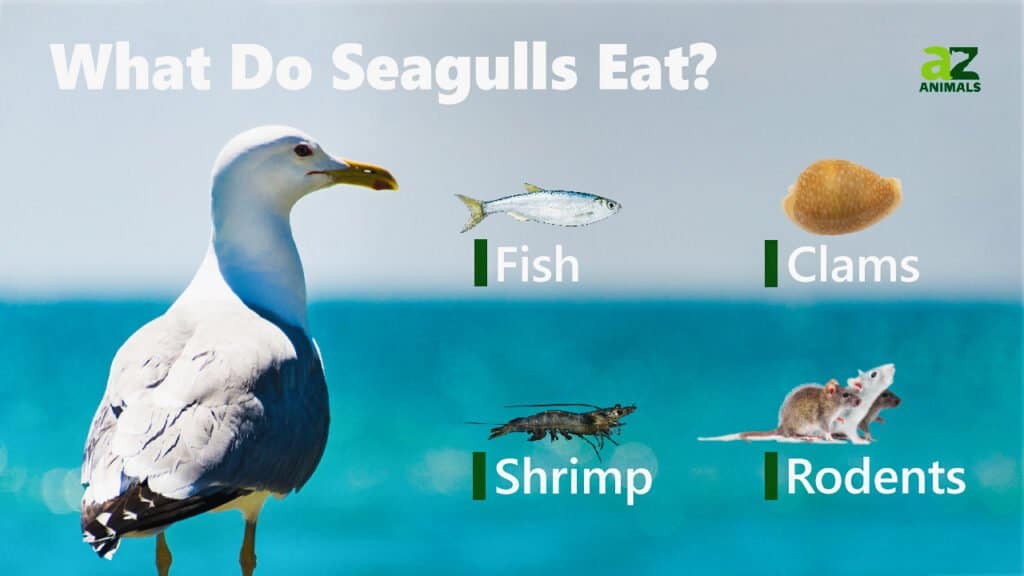
Most seagulls are obligate carnivores, sometimes supplementing their diets with bits of plant matter. They will often scavenge what they can from the surface of the ocean, beach, or land. These bold birds will even snatch food right out of a person’s hands.
What does the seagull eat?
The seagull eats a wide range of different foods. Its diet normally consists of fish, insects, earthworms, mollusks, rodents, small reptiles and amphibians, fruits and seeds, and even other birds and their eggs. They will prowl the same scavenging sites every day or fly high up in the air, diving down to pick off prey. However, they are not capable of diving down deep below the surface of the ocean.
Want more details on what seagulls eat? Give our complete ‘What Do Seagulls Eat? 25+ Foods That Seagulls Love‘ guide a look!
Predators, Threats, and Conservation Status
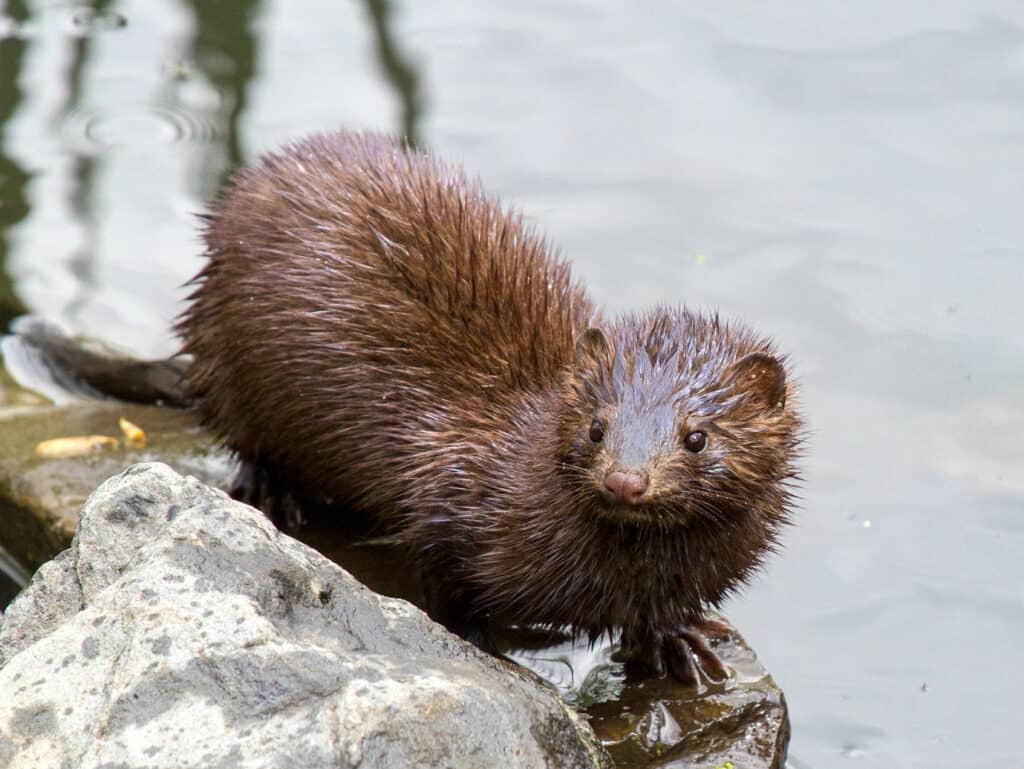
Mink are known to hunt seagull chicks and their eggs
Seagulls are highly versatile and adaptable birds. The vast majority are considered to be species of least concern by the IUCN Red List, although several species like the lava gull and the kittiwake are vulnerable to extinction. Climate change, pollution, loss of coastal habitat, overfishing, and deliberate hunting may be responsible for a downward trend in numbers.
What eats the seagull?
Baby seagulls and the eggs are often preyed upon by raccoons, minks, foxes, cats, and birds of prey. Adult gulls are less in danger of being eaten, but they’re sometimes preyed upon by particularly large and dangerous predators. Groups of seagulls will often mob a predator and strike with their wings and feet to drive it away.
Reproduction, Young, and Molting

Both male and female gulls take turns hatching the egg and caring for their chicks
©zahorec/Shutterstock.com
The seagull’s reproductive season usually occurs in the early springtime after returning to the same site from the annual migration. They do show a tendency to take the same mate for life and may strengthen their bond through mutual feeding exercises. After mating, the female lays a clutch of up to three eggs per year. The parents will take turns incubating the egg for about a month, while the other parent hunts for food.
The parents will continue feeding the baby chicks until they’ve obtained their full-flight feathers a month or two after hatching. Many juveniles have a mottled brown appearance compared with the more solid colors of the adult plumage. It usually takes a few years to obtain full sexual maturity. Many species can live up to 30 years old; the oldest documented specimen was a 49-year-old white-headed gull.
Population

In spite of a decrease in some species, gulls number in the millions worldwide
©Patrick baehl de Lescure/Shutterstock.com
Seagull populations show an unfortunate downward trend in numbers. The American herring gull has an estimated population of some 246,000 breeding pairs, which is actually down from its peak. It’s estimated that numbers fell some 83% between 1966 and 2015. Altogether, millions of gulls can be found worldwide.
Gull Species
- Audouin’s Gull (Ichthyaetus audouinii)
- Andean Gull (Chroicocephalus serranus)
- Armenian Gull (Larus armenicus)
- Belcher’s Gull (Larus belcheri)
- Black-tailed Gull (Larus crassirostris)
- Common Gull (Larus canus)
- Gray Gull (Leucophaeus modestus)
- Iceland Gull (Larus glaucoides)
- Little Gull (Hydrocoloeus minutus)
- Hartlaub’s Gull (Chroicocephalus hartlaubii)
- Lava Gull (Leucophaeus fuliginosus)
- Saunders’s Gull (Saundersilarus saundersi)
- Sooty Gull (Ichthyaetus hemprichii)
- Olrog’s Gull (Larus atlanticus)
- Laughing Gull (Leucophaeus atricilla)
- Western Gull (Larus occidentalis)
- Yellow-legged Gull (Larus michahellis)
- Lesser Black-backed Gull (Larus fuscus)
- Great Black-backed Gull (Larus marinus)
- Silver Gull (Chroicocephalus novaehollandiae)
- Kelp Gull (Larus dominicanus)
- Heermann’s Gull (Larus heermanni)
- Bonaparte’s Gull (Chroicocephalus philadelphia)
- Glaucous-winged Gull (Larus glaucescens)
- Short-billed Gull (Larus brachyrhynchus)
- Franklin’s Gull (Leucophaeus pipixcan)
- Black-legged Kittiwake (Rissa tridactyla)
- Caspian Gull (Larus cachinnans)
- Glaucous Gull (Larus hyperboreus)
- Mediterranean Gull (Ichthyaetus melanocephalus)
- Brown-hooded Gull (Chroicocephalus maculipennis)
- Grey-hooded Gull (Chroicocephalus cirrocephalus)
- Slender-billed Gull (Chroicocephalus genei)
- Yellow-footed Gull (Larus livens)
- Pallas’s Gull (Ichthyaetus ichthyaetus)
- Sabine’s Gull (Xema sabini)
- Slaty-backed Gull (Larus schistisagus)
- Swallow-tailed Gull (Creagrus furcatus)
- Brown-headed Gull (Chroicocephalus brunnicephalus)
- White-eyed Gull (Ichthyaetus leucophthalmus)
- Ross’s Gull (Rhodostethia rosea)
- Relict Gull (Ichthyaetus relictus)
- Red-legged Kittiwake (Rissa brevirostris)
Up Next…
- Seagull Lifespan: How Long Do Seagulls Live? Want to learn more about seagulls? Click here for more information.
- What Do Seagulls Eat? 25+ Foods That Seagulls Love Commercial fishing has a big impact on seagulls. Click here to learn more about their feeding habits.
- Albatross vs Seagull: What are the key differences? You’ve probably heard of an Albatross, but can you tell what they look like? Read on to find out.
Seagull FAQs (Frequently Asked Questions)
What is a seagull?
The gull is a medium to large-sized seabird that lives along coasts all over the world.
Does the seagull migrate?
Northern populations do tend to migrate south for the winter.
How many eggs does the seagull lay?
Most gulls can lay a single clutch of up to three eggs at a time.
How fast does the seagull fly?
Most seagulls travel at speeds between 20 and 40 miles per hour.
What is the seagull’s wingspan?
The largest species, the great black-backed gull, has a wingspan of more than 5 feet long. The typical American herring gull has a wingspan of 4 to 5 feet.
What does a seagull look like?
The seagull tends to be a large stout bird with long wings and thin legs. The bill is long and hooked at the end with a darker or lighter marking at the tip. Most species are covered in unassuming white, gray, and black plumage.
What do seagulls eat?
Seagulls will eat almost any small animals they can find. Fish and mollusks are among their favorites, but they are truly opportunistic birds.
Are seagulls intelligent?
Yes, these seabirds are highly intelligent. They have demonstrated many different strategies to obtain food, including some limited tool use.
What is special about a seagull?
As anyone who has visited a beach can probably attest, seagulls are among the most tenacious birds in the world. They will take an easy meal by stealing food from other animals or humans.
Thank you for reading! Have some feedback for us? Contact the AZ Animals editorial team.
Sources
- Britannica / Accessed December 13, 2021
- TheCornellLab / Accessed December 13, 2021
- OneKindPlanet (1970) https://onekindplanet.org/animal/seagull/ Jump to top / Accessed December 13, 2021


















